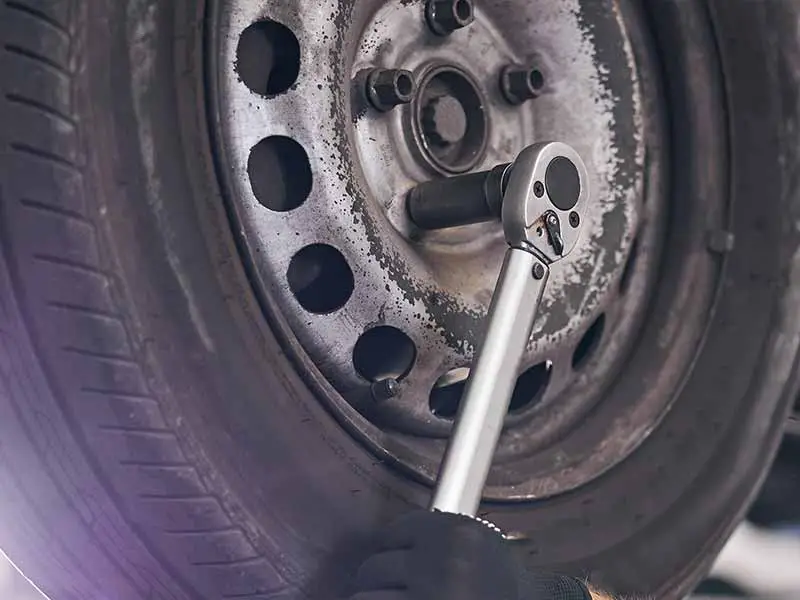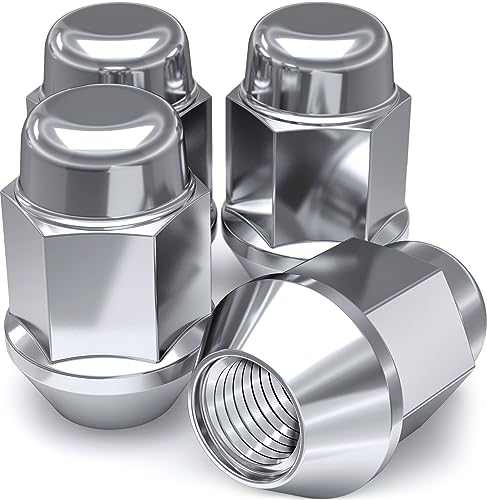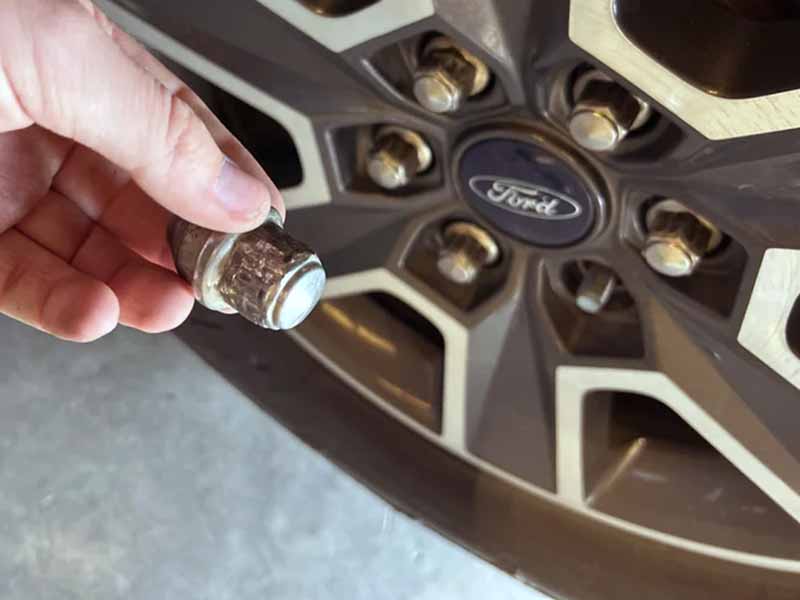You’ve just spotted an empty spot where a lug nut should be on your wheel, and a wave of concern washes over you. Where do you even start with getting a replacement, and how can you tell if there’s more damage than meets the eye? This article is meant for anyone standing in front of their vehicle, puzzled by a missing lug nut, and seeking clear, straightforward guidance on what to do next.
How To Replace A Missing Lug Nut
To replace a missing lug nut, identify the correct type and size for your vehicle, screw it on by hand to avoid cross-threading, and then tighten it with a torque wrench to the manufacturer’s specifications. For a broken wheel stud, professional replacement is recommended for safety.
In this article, you will learn the step-by-step process of replacing a missing lug nut, how to identify the right type for your vehicle, and why professional help is essential for a broken wheel stud.

Understanding Lug Nuts and Wheel Studs
Lug nuts and wheel studs are crucial parts of your car. They work together to keep your wheels attached to the car. If they’re not all there or not working right, it can be unsafe.
What Are Lug Nuts and Wheel Studs?
- Lug Nuts: These are the small parts you see on the outside of the wheel. They twist onto something called a wheel stud to hold the wheel tight.
- Wheel Studs: These are like long bolts attached to the wheel hub. They stick out so the lug nuts can be twisted onto them.
Why They Matter
Without lug nuts and wheel studs, your wheels could come off while driving. That’s dangerous. It’s important to make sure they are all in place and not broken.
The Risk of Missing or Broken Parts
- Missing Lug Nut: If one lug nut is gone, it puts more stress on the others. This could lead to more problems.
- Broken Wheel Stud: A broken stud is worse because it means the wheel is not held on as strongly as it should be.
If you’re dealing with a broken wheel stud, it’s a bit more complicated to fix. You might need to see a professional. I recommend reading about wheel stud replacement to understand this better.
Driving With a Missing Lug Nut
It’s not a good idea to drive with a missing lug nut. The other lug nuts could loosen because they’re working harder. If you want to know more about this, check out how long can you drive with a missing lug nut.

Lug Nut Types
Identifying Your Lug Nut Type
When you need to replace a lug nut, it’s not as simple as buying any lug nut. Cars and trucks have different kinds of lug nuts. It’s important to get the right kind for your vehicle.
Different Types of Lug Nuts
There are a few types of lug nuts, and each one fits a certain kind of wheel:
- Conical Seat: These lug nuts have a cone-shaped bottom. They fit into a cone-shaped space on the wheel.
- Ball Seat: These have a round bottom. They match up with a round space on the wheel.
- Flat Seat: These lug nuts have a flat bottom. They sit on a flat surface on the wheel.
How to Know Which One You Need
To find out what kind of lug nut your car or truck needs, you can:
- Check the Owner’s Manual: This book that comes with your vehicle tells you what kind of lug nuts to use.
- Look at Your Current Lug Nuts: Take off one of the other lug nuts and see what the bottom looks like. Is it cone-shaped, round, or flat?
- Ask at an Auto Parts Store: You can take one of your other lug nuts to the store and ask for help finding the same kind.
Matching the Threads
The threads are the spiral lines on the stud and inside the lug nut. They need to match so the lug nut can twist onto the stud properly. If they don’t match, the lug nut won’t fit right, and that’s not safe.
- Check the Size: Lug nuts come in different sizes. You need to know the right size for your vehicle.
- Check the Thread Pitch: This is how close together the threads are. If they’re too close or too far apart, the lug nut won’t screw on.
When you go to buy a new lug nut, make sure you get one that has the same size and thread pitch as the ones on your vehicle. If you’re not sure, an auto parts store can usually help you find the right one.
When to Seek Professional Help
Sometimes, fixing your car is not a do-it-yourself job. If you have a broken wheel stud or other serious issues, it’s best to get help from someone who fixes cars for a living.
Recognizing When You Need a Pro
Here’s how you can tell if you need to see a mechanic:
- Broken Wheel Stud: If the stud is broken, it’s not just about screwing on a new lug nut. The whole stud has to be replaced, and that’s a job for a professional.
- Multiple Missing Lug Nuts: If more than one lug nut is missing, it could mean there’s damage you can’t see. A mechanic can check everything is okay.
- Unsure About Lug Nuts: If you’re not confident about choosing the right lug nut or screwing it on properly, ask for help. It’s better to be safe.
Where to Go
You have a few options for getting help:
- Local Garage: A nearby mechanic can usually fix things like this.
- Dealership: If your car is still under warranty, the dealership might fix it for free.
- Auto Parts Store: Some stores can give you advice or even help you with simple fixes.

Lug Nuts
Selecting the Right Replacement Lug Nut
Choosing the correct replacement lug nut is crucial for your vehicle’s safety. Here’s how to make sure you get the right one.
Finding the Correct Lug Nut
To avoid mistakes, follow these steps:
- Know Your Vehicle’s Specifications: Look in your owner’s manual or ask at an auto parts store. They can tell you exactly what kind of lug nut you need.
- Match the Lug Nut to Your Vehicle: Make sure the new lug nut is the same type and size as the ones already on your car.
Buying the Lug Nut
When you go to buy a new lug nut, keep these points in mind:
- Buy from a Reputable Source: An established auto parts store or dealership will have quality parts.
- Avoid Mismatched Lug Nuts: Don’t just buy any lug nut that fits. It should match the others in size, shape, and type.
Installing the New Lug Nut
Once you have the right lug nut, you need to install it correctly:
- Screw it on by Hand First: This helps you feel if it’s going on smoothly and not cross-threading.
- Use a Lug Wrench: Once it’s on by hand, use the wrench to tighten it until it’s snug.
Double-Checking Your Work
After you put on the new lug nut, make sure:
- It’s as tight as the others. You can use a torque wrench to make sure it’s just right.
- It looks like the other lug nuts. If it’s sticking out or in more than the others, something might be wrong.

Torque Wrench
The Replacement Process
Replacing a missing lug nut is a task you can often do on your own. Here’s a step-by-step guide to ensure you do it properly.
Step-by-Step Lug Nut Replacement
- Gather Your Tools: You’ll need a lug wrench and a torque wrench. These tools help you remove the old lug nut and install the new one correctly.
- Remove the Wheel Cover: If your car has a hubcap or wheel cover, take it off to reach the lug nuts.
- Loosen the Other Lug Nuts: Before lifting your car, slightly loosen the other lug nuts. This makes it easier to remove the wheel if needed.
- Lift the Car: If you need to remove the wheel to access the lug nuts, use a jack to lift the car. Make sure you do this safely.
- Remove the Wheel: If you’ve lifted the car, now you can take off the wheel.
- Install the New Lug Nut: Screw the new lug nut onto the stud by hand to make sure it doesn’t cross-thread.
- Tighten the Lug Nut: Use the lug wrench to tighten the new lug nut as much as you can by hand.
- Lower the Car: If you’ve removed the wheel, put it back on, and lower the car back down.
- Final Tightening: Use a torque wrench to tighten the new lug nut to the manufacturer’s specifications. This is very important for your safety.
Ensuring Correct Tightness
- Use a Torque Wrench: This tool lets you apply a specific amount of force, or torque, to the lug nut. It’s the best way to make sure it’s not too loose or too tight.
- Check the Torque Specifications: You can find the correct torque in your owner’s manual or from an auto parts store.
- Tighten in a Star Pattern: When tightening the lug nuts, move in a pattern that goes across the wheel. This helps make sure the wheel is evenly attached.
After the Replacement
Once you’ve replaced the lug nut:
- Check All Lug Nuts: Make sure all the lug nuts are tight. Use the torque wrench on each one.
- Test Drive: Take a short drive, then check the lug nuts again. They should be just as tight as before the drive.
- Regular Checks: It’s a good idea to check the tightness of the lug nuts from time to time, especially before long trips.
Resources
Below are some links you may find helpful when learning about tires:
Final Thoughts
Replacing a missing lug nut or addressing a broken wheel stud are essential tasks for maintaining your vehicle’s safety and performance. This article has walked you through identifying the correct lug nut for your car, the importance of professional help for broken wheel studs, and the steps to replace a lug nut properly.
Remember, while some car maintenance tasks can be done at home with the right tools and knowledge, never hesitate to seek professional help when in doubt.
Good luck and happy motoring.





